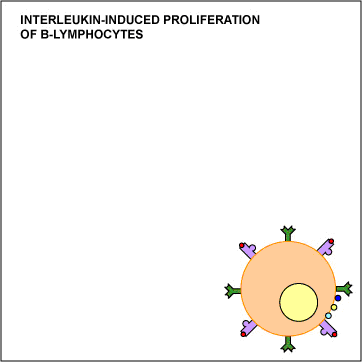
In the case of T-dependent antigens, an effector T4-helper lymphocyte, by way of its TCR and CD4, binds to the MHC-II/epitope on the activated B-lymphocyte. This, along with co-stimulatory signals that result from the binding of costimulatory molecules such as CD40 and B7 on the B-lymphocyte with their corresponding ligands on the activated T4-lymphocyte enable the T4-helper cell to release cytokines that bind to cytokine receptors on the activated B-lymphocyte triggering its proliferation into a large clone of identical B-lymphocytes. The clone of B-lymphocytes eventually differentiates into antibody-secreting B-lymphocytes and plasma cells. Some of the B-lymphocytes also differentiate into B-memory cells for heightened secondary response against that T-dependent antigen.
GIF animation illustrating Proliferation and Differentiation
of a B-Lymphocyte after Interaction with
an Effector T4-Helper Lymphocyte .swf by Gary E. Kaiser, Ph.D.
Professor of Microbiology,
The Community College of Baltimore County, Catonsville Campus
This work is licensed under a Creative Commons Attribution 4.0 International License.
Based on a work at http://faculty.ccbcmd.edu/~gkaiser/index.html.
Last updated: August, 2018
Please send comments and inquiries to Dr.
Gary Kaiser